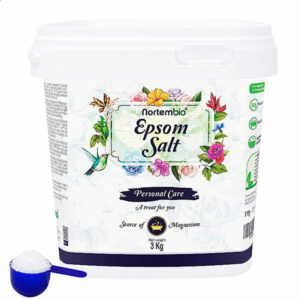Why You Should Soak Your Feet in Epsom Salts
 Dear Readers,
Dear Readers,
There’s something soothing about a warm foot bath at the end of a long day. But did you know that adding a simple ingredient like Epsom salts could transform this relaxing ritual into a health-boosting practice? That’s right – the humble Epsom salts have the potential to help those suffering from a range of issues, including fungal nail infections. In this blog post, we’ll dive into the benefits of soaking your feet in Epsom salts and provide some practical tips for you to get the most out of this practice.
Epsom Salts
The What and Why Epsom salts, chemically known as magnesium sulphate, are known for their range of therapeutic benefits. They are different from table salt (sodium chloride), and their name comes from a saline spring in Epsom, England, where they were first discovered. When dissolved in warm water, they release magnesium and sulphate ions, which are absorbed through the skin, offering a host of health benefits.
 Benefits of Epsom Salts Foot Baths
Benefits of Epsom Salts Foot Baths
- Reducing Itching and Inflammation: Soaking your feet in Epsom salts can alleviate the itching and inflammation associated with fungal nail infections and athlete’s foot. This is because of magnesium’s anti-inflammatory properties.
- Decreasing Symptoms of Athlete’s Foot: Epsom salts can help reduce the discomfort associated with athlete’s foot, a common condition often occurring alongside fungal nail infections.
- Promoting Relaxation: The warm water and magnesium work together to help relax the muscles and soothe tired feet.
However, it’s essential to remember that while an Epsom salts foot soak can alleviate symptoms, it is not a cure for fungal infections. It is best used as part of a broader treatment plan.
How to Use Epsom Salts
For an Epsom salts foot soak, fill a basin with enough warm water to cover your feet. Add a half cup of Epsom salts, stirring until dissolved. Soak your feet for 15-20 minutes, three times per week.
Remember, while Epsom salt soaks can be beneficial, overdoing them may lead to chronic dehydration. To counter this, it is wise to rehydrate after an Epsom salts soak with our recommended hydration supplement.
 This product combines quality and value, making it an excellent choice for regular foot baths.
This product combines quality and value, making it an excellent choice for regular foot baths.
Wrapping Up
An Epsom salts foot bath can be a simple, relaxing addition to your foot health routine, offering relief from some symptoms of fungal nail infections and athlete’s foot. Remember, while it can alleviate discomfort, it should be part of a comprehensive treatment plan for fungal nail infections. As always, maintaining a balance is key – not too little, not too much.
Here’s to healthier, happier feet!
Thanks for Reading!!
Ruth
DipCFHP
The Nail Cure
Disclaimer:
This blog provides general information and discussions about health and related subjects. The information provided in this blog, or in any linked materials, are not intended and should not be construed as medical advice. If the reader or any other person has a medical concern, they should consult with a healthcare provider.
Any application of the material provided in this blog is at the reader's discretion and is their sole responsibility. The author and the company will not be liable for any direct, indirect, consequential, special, exemplary, or other damages arising from the application of information in this blog.
This blog promotes a product where results may vary. The product complies with Irish and EU regulations.
Get Your Hands on the Ultimate Guide to Treating Nail Fungus Today!

TheNailCure.com
Your Passport to a Fungus-Free Future!
Subscribe today to our newsletter for the latest news!
